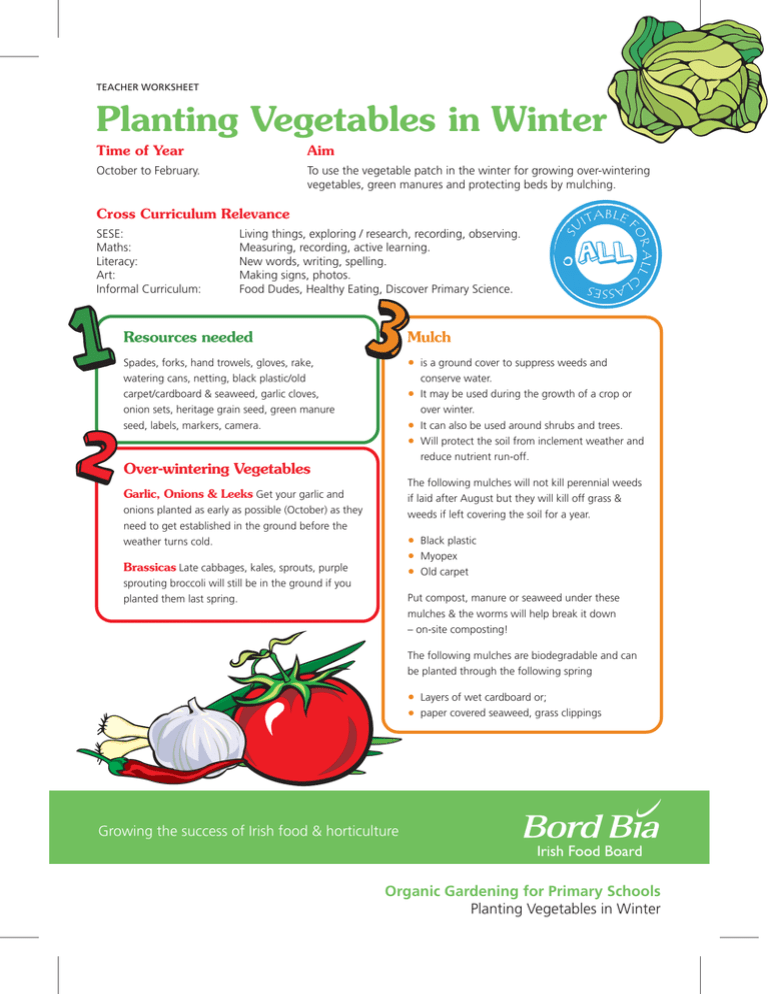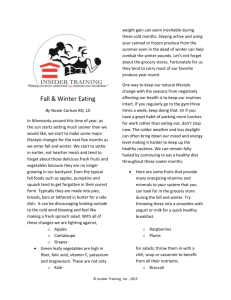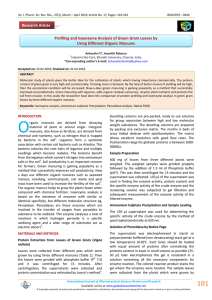Planting Vegetables in Winter
advertisement

TEACHER WORKSHEET Planting Vegetables in Winter Time of Year Aim October to February. To use the vegetable patch in the winter for growing over-wintering vegetables, green manures and protecting beds by mulching. Mulch Spades, forks, hand trowels, gloves, rake, watering cans, netting, black plastic/old carpet/cardboard & seaweed, garlic cloves, onion sets, heritage grain seed, green manure seed, labels, markers, camera. • • • • • • • Over-wintering Vegetables C Resources needed S All AL L Living things, exploring / research, recording, observing. Measuring, recording, active learning. New words, writing, spelling. Making signs, photos. Food Dudes, Healthy Eating, Discover Primary Science. BL ITA E F OR SESE: Maths: Literacy: Art: Informal Curriculum: U SSES LA Cross Curriculum Relevance is a ground cover to suppress weeds and conserve water. It may be used during the growth of a crop or over winter. It can also be used around shrubs and trees. Will protect the soil from inclement weather and reduce nutrient run-off. The following mulches will not kill perennial weeds if laid after August but they will kill off grass & weeds if left covering the soil for a year. Garlic, Onions & Leeks Get your garlic and onions planted as early as possible (October) as they need to get established in the ground before the weather turns cold. • • • Brassicas Late cabbages, kales, sprouts, purple sprouting broccoli will still be in the ground if you planted them last spring. Black plastic Myopex Old carpet Put compost, manure or seaweed under these mulches & the worms will help break it down – on-site composting! The following mulches are biodegradable and can be planted through the following spring • • Layers of wet cardboard or; paper covered seaweed, grass clippings Growing the success of Irish food & horticulture Organic Gardening for Primary Schools Planting Vegetables in Winter TEACHER WORKSHEET Planting Vegetables in Winter contd. Health & Safety Stay with your group. Use tools safely. Wash hands after garden session. Never eat anything without asking an adult – some plants can be poisonous. Please refer to the worksheet on Health & Safety for detailed information. Green Manures Where to go for more information? Green manures are plants that put nutrients back into the soil through their roots, they are often in the legume (pea) family as they fix nitrogen and this will be beneficial to the next crop planted in that bed. The internet/the library Green Manures, How to Grow Them www.gardenorganic.org.uk www.gardenorganic.org.uk/pdfs/ internationalprogramme/greenman.pdf Examples of green manures Clovers, vetch, field bean, phacelia, rye grain. Heritage Grain, Michael Mikilas, miggo@iol.ie or bdaai@indogo.ie How to plant • • Clear the bed of any weeds with forks/spades – put these in the compost heap. • • Water the bed thoroughly and scatter the green manure seed freely (broadcast) over the bed. • • • Rake it over gently with a rake or hand forks to cover the seed or use fingers to push the seeds • under the soil. • Make a label for the bed. • • Record it in the garden diary or take photos and make a slide show. • Dig in green manures before they go woody. Irish Seed Savers Association www.irishseedsavers.ie Fruit Hill Farm, www.fruithillfarm.com Green Manures - www.organiccatalogue.com Ideas for Research projects Maths – Estimate how much green manure is needed to cover a bed. SESE – have 3 pieces of soil; leave one bare, one with green manure and cover one with black plastic; plant the same crop in all three in spring and see which one does best. Local Heritage – do any local farmers use green manure? Art/Communications – make a display for the garden or green schools notice board about winter garden care, different mulches and green manures. Research Words: GREEN MANURE, MULCH Growing the success of Irish food & horticulture Organic Gardening for Primary Schools Planting Vegetables in Winter






